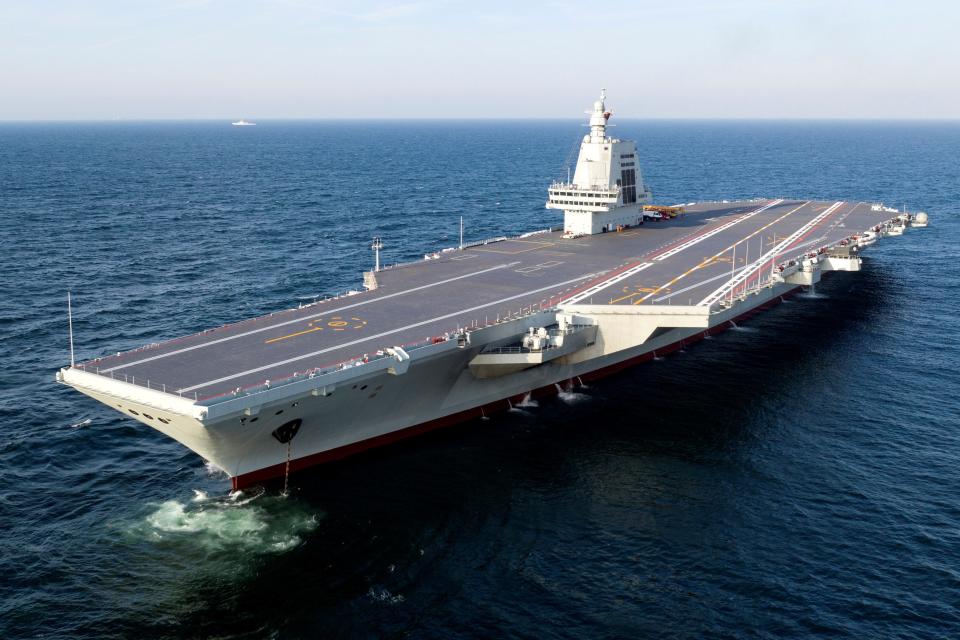-
A state-owned Chinese shipbuilder said it’s debuted the design of a “mothership” for its coast guard.
-
Military bloggers in China speculate that it might be an aircraft carrier or a drone platform for the high seas.
-
If so, it would be an unprecedented asset for a law enforcement agency, though Japan is also planning one.
In early August, military bloggers started buzzing about a small detail on a Chinese shipbuilder’s social media.
The state-owned 708th Shipbuilding Research Institute said on August 8 that it’s planning something new to meet the local coast guard’s needs — a “mothership” that can operate in the far seas.
Little else about the project was revealed. The announcement only said the institute had debuted the ship’s design at a coast guard equipment conference in Zhejiang.
The shipbuilder said the vessel was designed according to “system and mission requirements” from the coast guard.
But the Chinese words for “mothership” are also the words used for “carrier,” leading local bloggers to discuss in earnest what the new vessel could be.
A law enforcement agency running a carrier-equivalent ship would be unprecedented in a world where coast guards typically rely on smaller, faster ships.
Yet China has recently been looking into bigger and bolder vessels for its coast guard that are strikingly similar to its naval assets, indicating that Beijing has ambitious plans for the organization.
In the early summer, it sent two new gigantic “monster ships” into the South China Sea, startling its neighbors. Each displaces 12,000 tons and is 541 feet long, or three times the size of the US Coast Guard’s cutters.
“Size does matter,” John Michael Dahm, a former US Navy intelligence officer and a senior fellow at the Mitchell Institute for Aerospace Studies, told Business Insider. “A vessel’s size and displacement often translate directly into capabilities. A bigger ship means more people, more weapons, more fuel, more endurance, more range.”
Some bloggers speculated that the new “mothership” could be an aircraft carrier, though China’s coast guard rarely uses manned planes for its daily operations.
It’s more likely, others posited, that Beijing is planning a drone platform or helicopter landing dock that can sail on the high seas.
The world’s first drone carriers?
Without photos or videos of the design, international experts can only guess what form the ship will take.
Maritime drone platforms are still a novel concept, but there are signs that China is building at least one. In May, Dahm identified a large Chinese ship under construction at a Jiangsu shipyard, which he said is likely the world’s first dedicated drone carrier.
Still, that shipyard is run by a different shipbuilder, so there’s no evidence that this Jiangsu carrier is related to the coast guard “mothership.”
To Dahm, it’s not yet clear if this new coast guard vessel is even equivalent to a carrier in function or tonnage.
“I’m often surprised by how right Chinese bloggers can be about these sorts of things, but in this case, I think they may be overselling ‘mothership,'” he said.
The 708th Shipbuilding Research Institute said the “mothership” would provide “comprehensive support,” and Dahm believes smaller Chinese coast guard vessels could fit the bill.
“I think the Chinese are trying to create more options,” said Collin Koh, a senior fellow at the Institute of Defence and Strategic Studies at Singapore’s Nanyang Technological University.
Koh also thinks the “mothership” is more likely a drone carrier, at about 10,000 to 20,000 tons, instead of a full-size aircraft carrier at 85,000 tons.

China’s coast guard already has a large fleet of more than 200 patrolling vessels. But if it wants to further contest territory in the South China Sea — its most high-profile area of operations — it has to figure out how to efficiently repair and resupply its ships at a distance.
A drone carrier could circumvent that issue, Koh said, allowing Beijing to maintain a 24/7 presence by deploying in a central location and sending out the drones repeatedly.
“If you put drones and small craft into a very strategic area, it could have a pretty big coverage. That’s likely the Chinese strategy,” Koh said.
Notably, Japan is planning a similarly massive coast guard vessel that it says will displace some 30,000 tons and be an “offshore base” for other ships. The largest ship in its current coast guard fleet is 6,500 tons.
China saying ‘far seas’ could be a clue
The 708th’s description of its new vessel as a “far seas” support ship also indicates that Beijing may have plans to use its coast guard further abroad.
China has, in the last 10 years, promoted the idea of defending its interests overseas with naval assets, in the same way that the US Navy patrols waters all over the world.
“As part of its Belt and Road Initiative strategy, China seems to be growing the role and presence of its coast guard in the South Pacific, after doing the same in Southeast Asia,” said Benjamin Blandin, a researcher and network coordinator at the Yokosuka Council on Asia-Pacific Studies.
“But there is a big step from planning to operational reality,” he added. China still needs a network of ports and resupply points to operate efficiently on the high seas.
Dahm said China will have an easier time putting its ships in foreign territory if they’re painted in coast guard livery.
“Having coast guard vessels working with host nation law enforcement is a much better look for China than a big gray warship bristling with missiles,” he said.
The international press center for China’s foreign ministry did not immediately respond to a request for comment sent by Business Insider.
Read the original article on Business Insider









